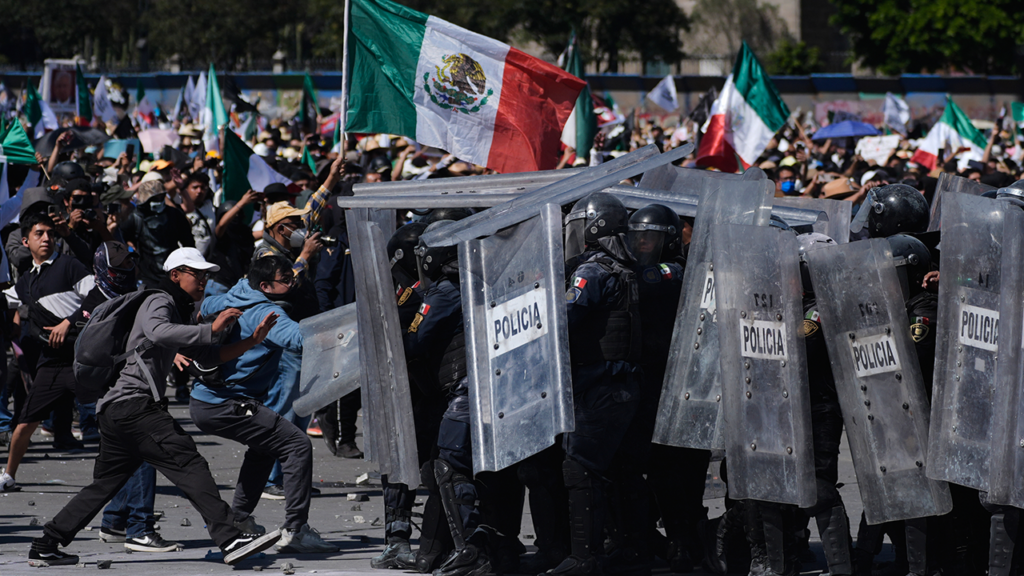Thousands of protesters descended on Mexico City on Saturday, November 15, 2025, engaging in violent confrontations with police during an anti-government march in Zocalo Square. The demonstrators, primarily members of Gen Z, protested against widespread corruption and increasing safety concerns amid escalating violence attributed to organized crime. As the situation intensified, authorities reported numerous injuries among police officers and several detentions while emphasizing their restraint in handling the protests.
| Article Subheadings |
|---|
| 1) Overview of the Protest |
| 2) Details of Violence and Police Response |
| 3) Voices from the Demonstrators |
| 4) Government’s Reaction and Outlook |
| 5) Implications for the Future |
Overview of the Protest
On Saturday, November 15, 2025, Mexico City witnessed a significant anti-government protest that turned violent, particularly in the historic Zocalo Square. This protest was primarily organized by younger citizens, specifically those belonging to Generation Z, who feel disenfranchised and unsafe in their own country. Amidst rising crime rates and widespread corruption, these young individuals took to the streets to voice their discontent against the current administration and the situation in Mexico, reflecting a deep-seated frustration that has been brewing in society for years.
Details of Violence and Police Response
As the protest escalated, chaotic scenes unfolded in the streets, marked by clashes between demonstrators and police. Authorities reported that at least 60 police officers sustained minor injuries during the confrontation. Some officers were subjected to physical attacks, while others experienced explosive devices being thrown in their direction. The Secretariat of Citizen Security reported that 40 officers required medical attention, with four needing specialized care due to trauma from the conflict. Amidst this turbulence, officials emphasized that police did not engage in violent repression but instead focused on containment, a decision that appears to have been made in light of the escalating tensions and past experiences with civil unrest.
Voices from the Demonstrators
Participants in the protest articulated their grievances clearly, highlighting concerns about corruption and the urgent call for enhanced public safety measures. Among them was Arizbeth Garcia, a physician who expressed her disillusionment with the current security situation, stating that “doctors are also exposed to the insecurity gripping the country, where you can be murdered and nothing happens.” Another demonstrator, Rosa Maria Avila, aged 65, shared her feelings of loss and anger stemming from the recent assassination of anti-crime mayor Carlos Manzo, which represented a significant blow to community efforts against organized crime. “The state is dying,” Avila lamented, emphasizing the necessity for a more aggressive stand against criminal elements that threaten public safety.
Government’s Reaction and Outlook
In light of the protests and the underlying dissatisfaction, President Claudia Sheinbaum has faced mounting criticism regarding her administration’s handling of security issues. Appointed as Mexico’s first female president in October 2024, she is accused of failing to adequately address the spiraling violence fueled by drug cartels. Critics assert that her government’s inaction and tolerance for organized crime only exacerbate public unrest. Following the assassination of Carlos Manzo, who had previously criticized the president for her lack of decisive action against criminal activities, the calls for reform within her administration have intensified. Sheinbaum has remained steadfast in her stance, previously rejecting military assistance from external forces to combat the problem, thus asserting Mexico’s sovereignty in dealing with its issues.
Implications for the Future
The incidents that transpired in Mexico City on November 15 may have far-reaching implications for the future of governance and civil society in Mexico. With rising dissatisfaction among the youth, the potential for further escalations in public protests is high if the issues surrounding corruption and safety remain unaddressed. The government’s response will play a crucial role in determining whether these tensions can be defused or if they will continue to escalate into more widespread unrest. The ongoing confrontations highlight an urgent need for comprehensive reforms within the justice and public safety sectors, coupled with an inclusive dialogue between the government and the residents that could pave the way for restoring public trust and safety.
| No. | Key Points |
|---|---|
| 1 | Thousands protested in Mexico City against government corruption and crime. |
| 2 | Violence broke out, resulting in injuries for over 60 police officers. |
| 3 | Protesters voiced concerns about public safety and systemic corruption. |
| 4 | President Claudia Sheinbaum faces criticism for her administration’s response to violence. |
| 5 | Future protests may escalate if governmental reforms are not enacted. |
Summary
The protests in Mexico City reflect a critical moment in the nation’s socio-political landscape, highlighting the growing unrest among younger generations over issues of corruption and safety. As public demands intensify for governmental accountability and reform, the administration’s response will be pivotal in shaping the trajectory of public sentiment and future demonstrations. Without effective measures to address these concerns, the potential for continued civil unrest remains significant.
Frequently Asked Questions
Question: What were the main reasons for the protests in Mexico City?
The protests were primarily driven by concerns over government corruption and the increasing levels of violence and insecurity faced by citizens, particularly among the youth.
Question: How did the police respond to the protest?
Authorities emphasized that the police focused on containment rather than repression, although they faced violent confrontations resulting in injuries to many officers.
Question: What implications do these protests have for the future of Mexico?
The protests suggest that if the government does not address the underlying issues of corruption and public safety, there may be an increase in civil unrest and protests in the future.
